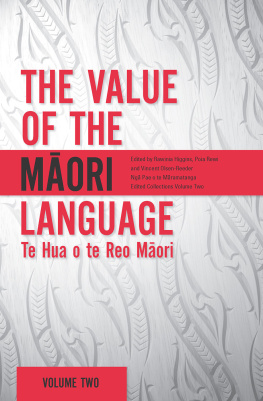Over the several years I have spent researching this subject I have been helped by a large number of people and the assistance of all of them is greatly appreciated.
Many tangata whenua throughout Aotearoa have given me their time and hospitality for which I am very grateful. More importantly, they have shared their knowledge in the wish that it survive and be available to this and succeeding generations. These include: Mr R.P. Emery (Te Kuiti), Mrs Aroha Greenland (Taumarunui), Mr Eparaima Te Paa (Ahipara), Miss Christina Lyndon, (Whangarei), Mr Sandy Stewart (Kerikeri), Mr Walter Hauraki (Omanaia), Mr Dick Himona, Mr and Mrs Jim Rimene (Masterton), Mr Piri Sciascia (Wellington), Mr Timi Kara Tewai (Ronnie) Bell (Mahanga), Mr Rua Niania, Mr and Mrs J. Robinson (Iwitea), Mr Teti Peka (Kihitu), Mr and Mrs Mac Whaanga (Mahia), Mr Api Hape, Mrs Maria Thompson, Mr Turi Tipoki, Mr Horace Whaanga (Wairoa), Mr M. Delamere, Mr and Mrs Tiwai Amoamo (Opotiki), Mr and Mrs Anaru Kohu, Mrs Meri Lucas, Mrs Pera Nuku, Mrs Nancy Tippett (Tauranga), Mr Hawiki Ranapia (Motiti), Mr William Pakeha (Te Teko), Mrs Elizabeth Murchie (Rotorua).
Some of these people have already passed on by the time this could be completed. Ki a koutou ka whakapai ahau mo ta koutou atawhai.
A great number of other people have assisted this work in many ways, and to these I must also express my gratitude Dr Harold W. Turner (Birmingham, England), Mr G.L. Baker (Patea), Mrs Margaret Dysart (Blenheim), Mr Bernard Teague, Mrs Thelma Teague, Mr Dave Hughes (Wairoa), Mr Keith Cairns (Masterton), Dr and Mrs R.M.S. Taylor (Papatoetoe), Mr Richard Hill, Mrs Tolla Williment, Rev. Dr M.W. Mulcahy (Wellington), Mr D.H. Maxwell, Mr A.H. Matheson (Tauranga), Mr Frank Davis (Palmerston North), Mr Bill Dacker (Dunedin), Mr A. Van der Wouden (Whakatane), Mr H.G.D. White (Opotiki), Mr W. Greenwood (Timaru), Mr J.R. Downs (Hamilton), Father J. Durning (Wanganui).
The staff of a number of libraries and government departments have been very helpful, and this assistance is also acknowledged with sincere thanks: Alexander Turnbull Library (National Library of New Zealand/Te Puna Matauranga o Aotearoa), General Assembly Library, National Archives (Wellington), Hocken Library (University of Otago), Auckland Public Library, Auckland War Memorial Museum Library, St Johns College Library, Hawkes Bay Museum Library, Bernard Sladden Library and Tauranga Public Library (Tauranga), Hamilton Public Library, University of Waikato Library, Wanganui City Library, Hawera Library, Taranaki Museum, University of Birmingham Library, Selwyn College Library (Cambridge, England), Department of Justice, Department of Statistics, Police Department. In addition, much appreciated help with research has been given by the Wesley Historical Society, Brother Gerard Hogg and Miss M. Lindsay of the Provincial Archives of the Society of Mary (Wellington).
Special thanks are due to Dr J. Veitch of Victoria University for the time, help, and valuable suggestions given, and to Dr P. Donovan (Massey University) and Dr Harold W. Turner (Birmingham, England) for comments.
To my husband Ken, and children Candy and Aaron, my love and thanks for their continuing support and interest over the many years during which this project has taken up so much of my time and interest. Without this support, and particularly Kens technical help with a variety of complex problems relating to computers, it would not have been possible.
Although much has been written on New Zealand history following colonization , and a little about Maori reaction to the Christian missions, not enough consideration has been given to the relevant religious aspects involved.
The religious responses of the Maori have usually been regarded as protests against the social and political order of their time, and while this is accepted, the fact remains that because of the Maoris religiously-grounded approach to life, the responses themselves were religiously rather than politically oriented.
After the coming of the missionaries, dozens of movements and prophets arose to minister to the spiritual needs caused by the social problems. The purpose was the preservation of spiritual identity rather than political gain. This can be seen particularly in those responses which attempted to cut themselves off from the new system and return to the former ways. To hark back to the past is to seek affirmation of the moral and spiritual worth of a people this being the identity which is their very being.
Because of the previous lack of a comprehensive study of the Maori religious movements of the past, there has not been a work which displayed, from their own viewpoint, the Maoris spiritual reaction from the time of their first contact with the missions. This means that the definite pattern which occurred within this continuing response has been overlooked. Consequently, studies done in the past on one specific movement have tended to miss the full significance of the response when the movement has not been seen as forming part of a continuing and developing reaction.
They have also tended to undervalue the importance of the translation of the Bible into Maori.
This work attempts to increase understanding of the Maori religious response of the past and present in two main ways. Firstly, by giving an account of a large number of the religious movements which arose, the pattern which occurred in the overall response can be seen, so individual movements can be appreciated according to their place within it.
It also shows how the beliefs of particular movements were affected by the notions presented in the scriptures available at the time of their formation . The lessons which the Maori were to take from the scriptures largely determined how the movements manifested themselves when they did.
The periods suggested in this work, therefore, follow the dates of significance regarding the translation and availability of the various portions of the Bible. That these often correspond with those social and political seasons recognized by some historians supports the idea that the significance of this important factor has been undervalued previously.











